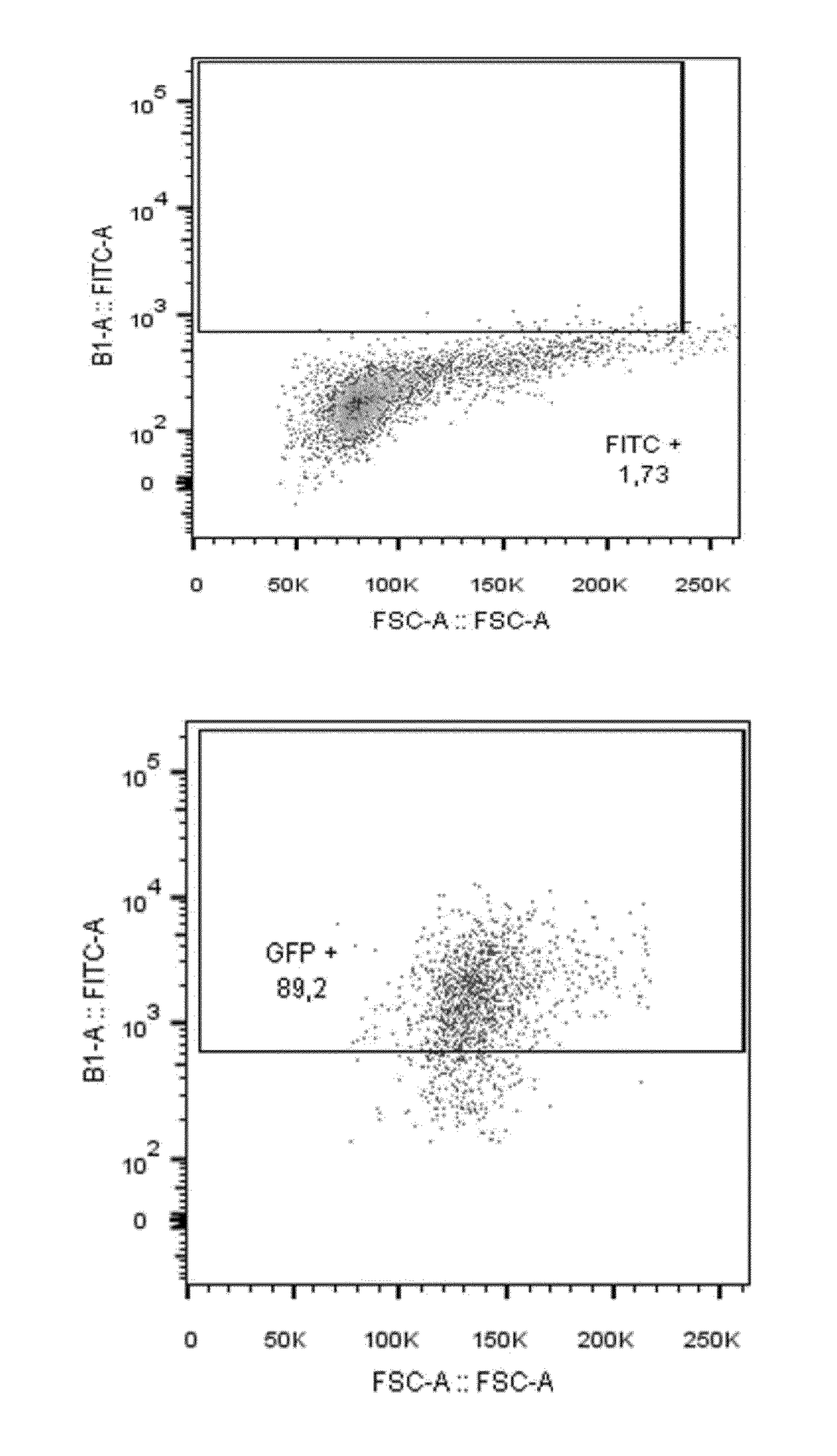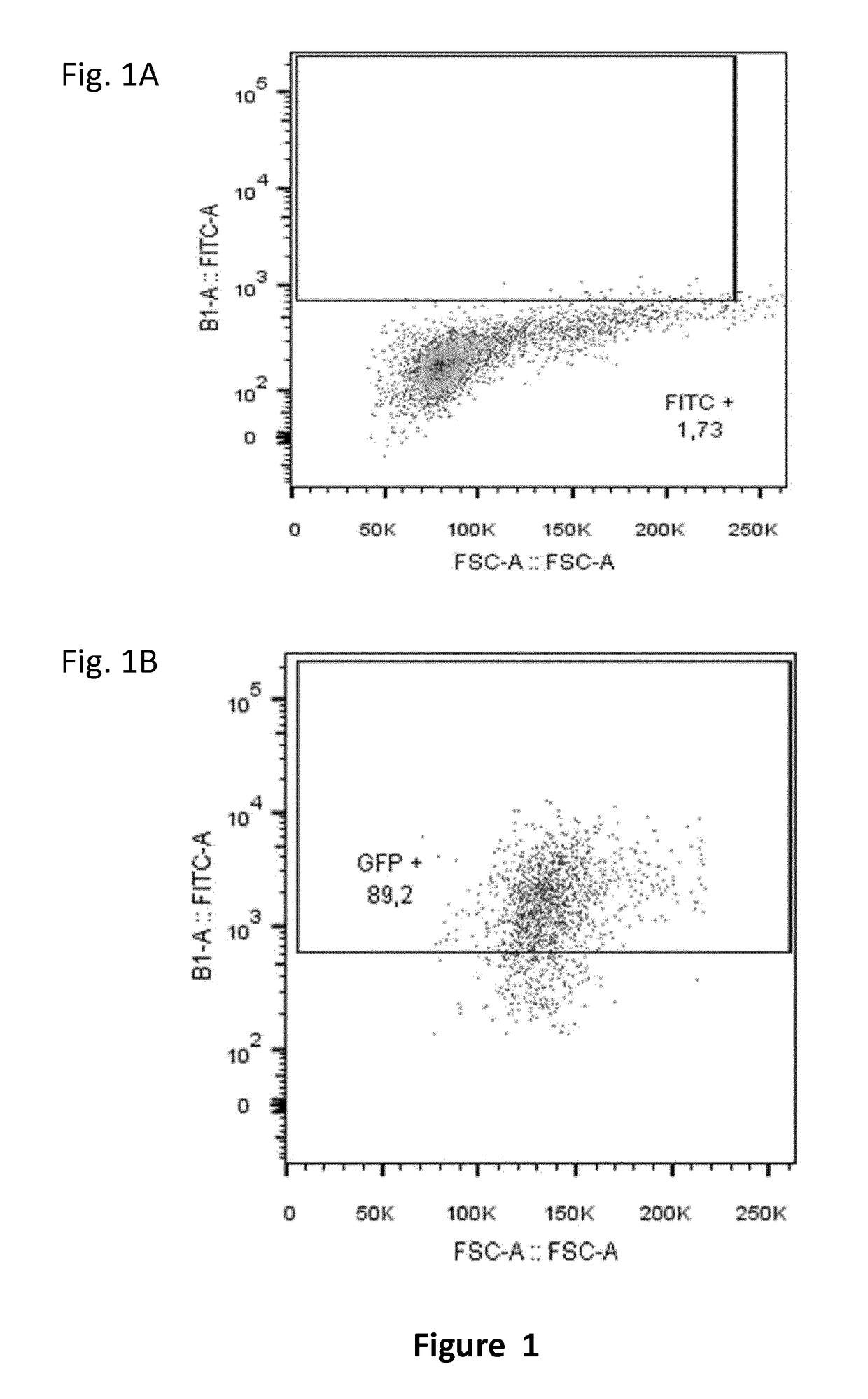Methods for improving functionality in nk cell by gene inactivation using specific endonuclease
a technology of nk cell and gene inactivation, which is applied in the direction of transferases, antibody medical ingredients, peptide sources, etc., can solve the problems of difficult to understand how nk cell activity is regulated, and achieve modest clinical success so far using nk cell-based therapies, and achieve efficient and durable response to tumors
- Summary
- Abstract
- Description
- Claims
- Application Information
AI Technical Summary
Benefits of technology
Problems solved by technology
Method used
Image
Examples
example 1
Transfection by GFP
[0268]A bulk of 2.5 106 NK cells from PBMCs of a healthy donor were transfected with 5 μg of RNA encoding for GFP (SEQ ID NO.30) in order to show the transfection rate compared to negative control (no RNA is transfected). After 72 hours of transfection, NK cells were labeled with FITC and analyzed by FACS.
[0269]The results are presented in FIG. 1. About 79% of GFP transfected NK cells are obtained compared to the negative control (no RNA). This experiment shows that NK cells the transfection conditions and protocol are satisfactory for carrying further genetic engineering experiments.
example 2
of Beta2 Microglobulin (β2M) Gene in NK Cell
[0270]Since NK cells alike all mammalian cells bear MHCI which is constituted of a heavy chain (variable and presenting the antigenic peptide) and a non-variable chain (beta2m). The absence of beta2m prevents the expression of the heavy chain on the cell surface, making the cells de facto MHCI KO. The Knock out of beta2 microglobulin (β2M) gene in NK cells aims to make them invisible to the host T cells. As all the cells from an individual carry the MHCI, constituted of a heavy chain (variable and presenting the antigenic peptide) and a constant chain (B2M). The absence of B2M prevents the expression of heavy chain on the cell surface, and thus a B2M KO cell is in facto MHCI KO.
[0271]A bulk of 2.5 106 NK cells from PBMCs of a healthy donor were transfected with 20 μg of RNA encoding for TALE-nucleases (SEQ ID NO:21 and 22) in order to inactivate the gene coding for beta2 microglobulin β2M). After 72 hours of transfection, NK cells were lab...
example 3
[0273]The presence of TGFβ at the plasma membrane of Treg has been shown to bind to TGFβ receptor expressed by NK cells and suppress their cytotoxic functions toward tumor cells. To prevent Treg dependant inhibition of NK cells, we inactivated their TGFβ receptor-target TGFβ coding sequence exon 2 (SEQ ID No 1) using Left TALEN arm (SEQ ID No 2) having DNA binding domain RVDs; Right TALEN arm (SEQ ID No 3) having DNA binding domain RVDs; all these sequences being inserted in Table 1. Transfection of mRNA encoding TALEN pair in NK cells resulted in efficient processing of TGFβ coding sequence and impairment of its surface membrane expression. Such inactivation resulted in the enhancement of NK cytolytic functions toward target tumor cells.
PUM
| Property | Measurement | Unit |
|---|---|---|
| Fraction | aaaaa | aaaaa |
| Fraction | aaaaa | aaaaa |
| Fraction | aaaaa | aaaaa |
Abstract
Description
Claims
Application Information
 Login to View More
Login to View More - R&D
- Intellectual Property
- Life Sciences
- Materials
- Tech Scout
- Unparalleled Data Quality
- Higher Quality Content
- 60% Fewer Hallucinations
Browse by: Latest US Patents, China's latest patents, Technical Efficacy Thesaurus, Application Domain, Technology Topic, Popular Technical Reports.
© 2025 PatSnap. All rights reserved.Legal|Privacy policy|Modern Slavery Act Transparency Statement|Sitemap|About US| Contact US: help@patsnap.com



